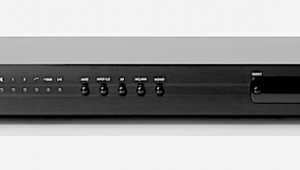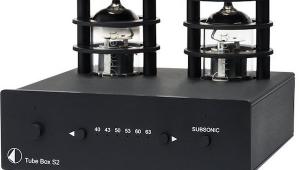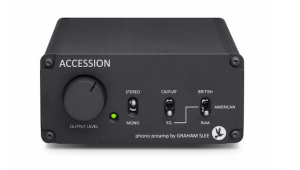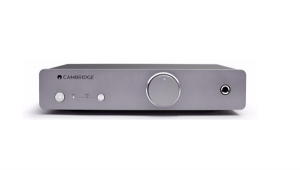Is there a subsonic filter? There should be in a $1k preamp.
Hagerman Audio’s “Tubey” But Quiet Trumpet MC Phono Preamplifier

The JFET input provides variable gain and loading, with split-passive RIAA equalization and 0 feedback throughout. The circuit description says the tube heaters are D.C. and that after a 40 second start up delay, “a highly specialized internal low-noise booster converter generates the B+ and B- rails”. Premium components used throughout include polypropylene capacitors and metal film resistors.
By high performance audio standards, the powdercoated aluminum chassis is thin (the whole thing weighs a mere 3 pounds), but consider that the Trumpet sells for $1099 and provides gain choices of 45dB, 55dB, 60dB, 64dB and 68dB—sufficient for even the lowest output MC cartridges.
Resistive loading choices are 47ohms, 100ohms, 220, 470, 1K and 47K—a sufficient range for most of us. For MM, capacitive loading is 220pF. Other claimed specs are: 10Hz-50kHz bandwidth, 70dBA ref 0.5mV (93dBA ref of full signal) noise, 0.04%@3Vrms distortion, 22Vrms@1% distortion and ±0.5dB RIAA accuracy.
Set-Up
I auditioned the Trumpet MC using both the Ortofon 2M Black 250 LVB and the Ortofon Cadenza Black mounted on the SME Model 6 turntable I reviewed in Stereophile.
The rear panel features chassis mounted gold plated RCA input and output jacks, a ground lug and an input pin for the outboard 15VDC “wall-wart” type power supply. Avoid stiff, heavy cables because unless carefully dressed they could displace or flip the lightweight chassis.
The front panel features a pair of “old school” knobs, the left one labeled “load”, the right one “gain”. Neither are marked so you have to read the instructions to know what’s what. A small pushbutton turns the Trumpet on. After an initial delay of a bit less than a minute the internal high voltage supplies turn on and shortly thereafter when both LEDs light yellow, the unit ready to play.
The instructions say “Best operation is to run LOADING as high as possible (clockwise) and GAIN as low as possible (counter-clockwise). MM cartridges will only function properly with LOADING set to 47kHz and gain at 44dB”. There’s a no 44dB setting so Mr. Hagerman means 45dB, or all the way to the left. 47kHz is with the loading knob fully clockwise.
The MC setting instructions are somewhat unusual. Is Mr. Hagerman suggesting running a low output moving coil cartridge loaded at 47kHz? Seems so but that’s clearly not correct so how can that be “best operation”? Hopefully he’ll answer in a comment. Setting gain as low as possible makes sense if you understand what exactly that means. Do you really want to run a .33mV Ortofon Cadenza Black, for instance, at 45dB gain, which is MM gain? I started there, dutifully following instructions but figured I’d try 55dB so I turned the knob one click and got a super-loud D.C. “THUMP” through the speakers that shut down my amplifiers. Be sure to hit the “mute” button before adjusting gain! That warning should have been in the instructions!
In the end Mr. Hagerman proved subjectively correct if objectively not. For whatever reason, 45dB was more than sufficient for the .33mV Cadenza and I was able to run my preamp at -19dB. This made little sense to me but again looking at the output of 22V (@1% distortion) it suddenly did!
Loading the cartridge at an appropriate 100 ohms produced too soft a top end, even though Ortofon recommends <10 ohms and normally a 5 ohm internal impedance cartridge loads at from 50 ohms to maybe a few hundred. Again Mr. Hagerman proved correct: I left the Trumpet MC at 47kHz because anything lower was too soft for my tastes. Still I wonder about this and hopefully the manufacturer’s comments will clarify.
Sounds “Thick and Rich” Yet Pleasingly Transparent Too
I allowed plenty of break-in time before serious listening, though over time the basis sonic signature did not change. Beyond the JFET input the Trumpet MC is a classic tube design that produced a classic tube sound, though it was also commendably quiet even being driven by low output MCs. So what’s “classic” tube sound? Start with a rich, full midrange that worked wonders on some thin, barren modern recordings and also did well with some older ones. Keep in mind though that I auditioned through the full range Wilson XVX loudspeakers that produce 20Hz (non-boomy) bass in my room. More likely the Trumpet MC will be paired with smaller two way bookshelf speakers or modest floor standers, or perhaps smaller planar magnetics like Magnepan 1.7is.
Neil Young’s recently released Young Shakespeare (Reprise 093624889519) referenced in the Ortofon 2M Black LVB 250 review benefited from the Trumpet MC’s rich midrange, producing a fully fleshed out Neil, center stage as my far more costly front end didn’t manage. Neil’s voice was bigger, more present (not as in bright) and more solid, though I think this is the result of a pleasing additive rather than a more accurate presentation of what’s in the grooves.
The remix of John Lennon’s essential first solo album John Lennon/Plastic Ono Band (0602507354541), which purposely adds body and texture to the original thin and somewhat distant original sounded solid and as intended, enriched by a solid kick drum foundation and full, but well controlled Klaus Voormann’s bass lines. This was a sonic presentation you could crank up to high SPLs and fully enjoy, though the lower-midbass was clearly slightly “thickened” and overall transients were slightly softened.
Female voices didn’t fare quite as well, with the added midband “thickness” impeding lightness and flow on recordings that should produce that. I revisited an old test pressing of Joni Mitchell’s Blue (Reprise MS 2308) mastered by Kevin Gray and Steve Hoffman July 5th 2006 at AcousTech Mastering and compared it to an original of the record, which was mastered by Bernie Grundman. Mitchell’s voice on both pressings had a slight but acceptable “chesty” quality when played back on my “big” front end (Mitchell’s voice “soared”), but it became excessive through the Trumpet MC.
On the other hand, the very bottom was solid and punchy, producing kick drums on most records that rocked with plenty of texture.
I think you get the picture: where there’s an acoustic guitar you get bountiful body and less string transient sparkle. Where there are bright cymbal splashes and crackling snare hits in a drum kit you get less transient “crunch” and snare “cracks” but more body and weight to tom hits.
Conclusion
The $1099 Hagerman Audio Trumpet MC offers big, warm “tube sound” in a compact, versatile package that can accommodate any MM or MC cartridge you choose to use it with. It will provide sufficient gain and low noise for even the lowest output cartridges and it will accommodate them all while producing quiet, hum-free backgrounds.
I’d advise pairing it with a lean or “analytical” cartridge and not with one that brings its own warmth to the table.
If you are looking for timbral neutrality and a light overall touch, the Trumpet MC might not be for you, though that depends on where your system’s sound is now and where you wish to take it. I’ve heard many systems thin in the midbass to midrange region where the Trumpet’s added weight and insistence in that area would be a welcomed addition, though that also depends upon the record!
One thing’s clear, if you are looking for an airy, bright top end and snappy “rhythm’n’pacing overall and a phono preamp “for all seasons”, the Trumpet MC is probably not be for you. If you luxuriate in Technicolor timbral riches and indulge in harmonic glorification and are looking to put some sock into your system, you will love this thing. That’s not a value judgement on my part, because I know plenty of listeners who do and as Pope Francis once famously said about another subject in his book, “who am I to judge?”
All products are handcrafted in the USA, come with a 10-year warranty, 30-day trial period, and free shipping world-wide (not including import duties, VAT, or other local taxes). So why take my word for any of this? Listen for yourself!
Specifications
• 47, 100, 220, 470, 1k, 47k ohm input impedance
• 45dB, 55dB, 60dB, 64dB, 68dB gain
• 220pF loading
• 10Hz to 50kHz bandwidth (-3dB)
• 70dBA ref 0.5mV signal-to-noise
• 0.04% @ 3Vrms distortion (1kHz)
• 22Vrms @ 1% overload (1kHz)
• +/-0.5dB equalization
• 12AX7 x 4, 12AU7 x 2
• 6 x 10 x 3.5 inches
• 3 pounds
• 15Vdc @ 2.05A
• 120V/240V operation
• Includes power supply & tubes
• Free shipping!
- Log in or register to post comments


First of all, thank you Mr. Fremer for such an in-depth and elaborate review!
Let me try and explain what I mean by running gain low and loading high. One thing I've observed over the past two decades of selling phonostages is that many customers like to operate gain as high as possible, thinking more is better. I am hoping to combat that myth, suggesting to treat gain more like a golf score.
You see, when gain is set too high in one stage, there is a tendency to overload the input of the following stage. This is especially true in phonostages because of the EQ involved, where the input signal for treble is 100 times greater than bass. If gain is set too high for a given cartridge, you will hear a harshness or brittleness as one of the gain stages is overloaded. You can test this for yourself!
Single-ended tube phonostages such as my Cornet3 overload via "blocking distortion", where high frequency signals drive the grid positive (with respect to cathode), which is then mildly rectified because of the sharp increase in grid current. If gain stages are capacitively coupled (most are), then you get a shift in dc bias, that quickly restores itself. It's a wonderful thing in a guitar amplifier, but not a phonostage! The Trumpet MC, thanks to balanced differential stages, is not prone to such blocking distortion, as it gets cancelled out. There are additional benefits to running long-tailed pairs, but that's another discussion.
Anyhow, that's why I suggest running gain as low as possible, as it aims for minimal distortion. I did not mean to imply operating a low output MC cart with MM gain, but rather to try and not start at maximum gain. For your Cadenza I would have suggested 60dB.
With loading I try to do a similar thing. At 47k an MC cart will sound very bright. As you drop the loading (lower resistance) the change will be audibly obvious. Now you know what to listen for! Keep going lower until tonality is balanced. Go too low and the life disappears and sound gets muddy.

Jim, since you're the manufacturer and you avoided answering my question, I'm guessing this confirms that you do not have a subsonic filter in your $1k+ preamp.

That Ypsilon phone pre better have 52 subsonic filters or Andy won't buy it.

It does have a subsonic filter, which you can see in the specifications, where the low frequency -3dB point is 10Hz. This is probably not the filtering you had in mind...
And I'm going to disagree with your premise. Expensive phonostages do not need rumble filters, cheap ones do!
You see, the problem of rumble depends on the quality of turntable (and stand). Hence, a cheap turntable likely requires such a feature. A decent table on the other hand, one that pairs well with a Trumpet MC, would provide enough acoustic isolation not to require a subsonic filter. Without such a rumble filter, the system will provide deeper and truer bass response, without the crazy phase shifts.

that is the question:
Whether 'tis nobler in the mind to suffer
The slings and arrows of outrageous digital audio,
Or to take arms against a sea of troubles
And by opposing end them.

Interesting. I assume fixed bias over cathode bias since the negative grid bias is supplied by the power supply. I get the DC heater supply but I wonder if its generated by a transformer or switcher. At only 3lbs I just wonder how you can deliver quiet DC B+ or otherwise.

Not even close. The topology uses long-tailed pairs, with grids biased at ground. Fully differential and balanced, including the power supplies.
Input power is 15Vdc. Heaters are then fed through series voltage-dropping resistors for soft-start (less in-rush current) and filtering. The 16 ohm resistor drops 2.4V at a nominal heater current of 150mA.
B+ and B- are derived using inductive boost converters operating at 67kHz. Voltage ripple at that frequency is much easier to filter compared to 120Hz. This helps to remove any residual hum and buzz (which cannot be underestimated). These circuits took me years to develop and optimize. It's not easy, which is why you don't see anyone else doing it.

Keep in mind ALL high voltage circuits used in tube amplifiers are "switching" types. Most of these switch at 120Hz (double the line frequency), which is right in the middle of the audio band, making it hard to filter and isolate.
This is why many manufacturers offer up two-box solutions, keeping the interfering power supply far away from sensitive and high gain audio circuitry. It's an approach that works well, but is costly.
I believe I've done better.

Hi Michael,
is this the same phono stage you reviewed on 12/7/2020? I'm thinking about a purchase. Thanks.

I ordered it. Jim’s shipping USPS. Honolulu to NYC. Given what I’ve experienced lately Post Office should have it in my hands by Labor Day 2021.

I live in NYC, and it only took a week! This was a few months ago.

I've known Jim Hagerman for years (built two of his kits, including the Coronet phonostage kit he once offered. Also use his UFO strobe to ensure proper platter speed). This is a great tube phonostage for the money, and in some ways I may like it better than my more expensive (and heavier) Convergent Audio Technology SL1 Reference MKIII tube phonostage. Mike's review is pretty spot on, it is for sure a tube phonostage with some midrange coloration, nobody would confuse it with solid state. It is for those that may want a certain "texture" in their vinyl playback, vs ultimate accuracy. That being said, I did two up grades that brought out even more performance:
1) Tube rolling. I bought a mix matched NOS 12AX7 (Tungsrams) and matched pair platinum select grade Gold Lion current production 12AX7, plus a matched pair of NOS Brimar 12AU7 from Upscale Audio. This unit reacts very much to tube rolling, and these tubes transformed to phonostage to another level of detail and "organic rightness" (if that makes sense). Wow factor is increased, etc. This preamps reacts to tube rolling for sure.
2) I replaced the wallwart with an SBooster Eco III power supply. This power supple features a very large toroidal transformer and a bank of filter capacitors, going beyond what the wallwart offers. (The power supply itself weighs probably twice as much as the phonostage itself! It's a beast). The upgraded supply was not night and day but at the sane time more than subtle. There was a slight increase in perceived output volume, better bass presentation, and slightly better resolution (things felt a little "smoother" and even more natural, and the top end improved a bit, especially with a sense of reverberant space in recordings, cymbals, etc). At $395 not cheap but not expensive either, I feel it's an upgrade worth considering if you are getting this phonostage. You have a 30 day trial at home to figure out if the SBooster offers enough improvement. For me, it did!

Hi Mark, You're right - I got the phono stage yesterday. Thanks for posting those tips. I have to get to know the Trumpet first. At some point down the road I may do some tube rolling. As to the power supply that's really intriguing. Thanks again.

I'm thinking about getting this, I'm conflicted because I'm not sure if it's worth the money or not. Suggestions? I'm wanting it for my own personal use as well as business use. Check out my blog at JackListens Com. Thanks!

good to see this posts you can get some info about jacklistens.com at our blog

Additionally, there will be only one test available for each transaction, and the question may only be answered by those who are lawfully residing in the region of the United States.https://jacklistensus.shop/

TellPopeyes surveys consumers to learn about their experiences and what can be done to improve the menu and give patrons the best possible dining experience at Popeyes restaurants.
Visit Here TellPopeyes Survey

The Jack in the Box Guest Satisfaction Survey 2025 is now available. Please provide your insightful comments regarding Jack in the Box Restaurant at www.jacklistens.com.
Jacklistens Survey

So that the SPAM is deleted.




















































